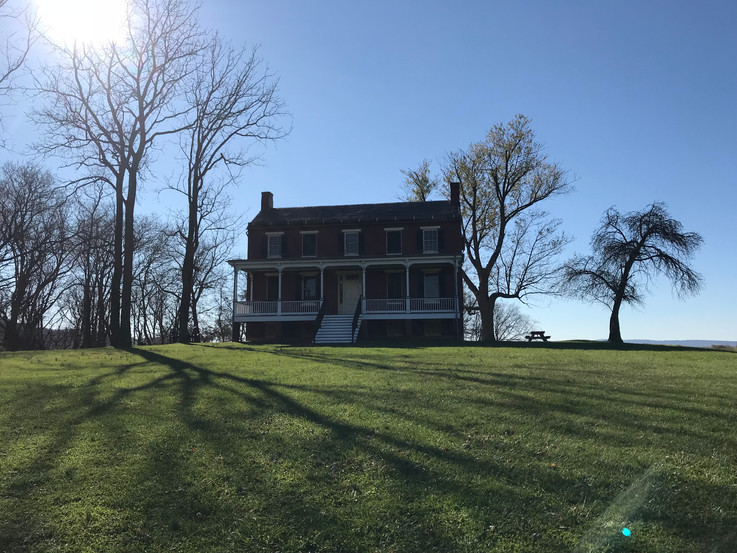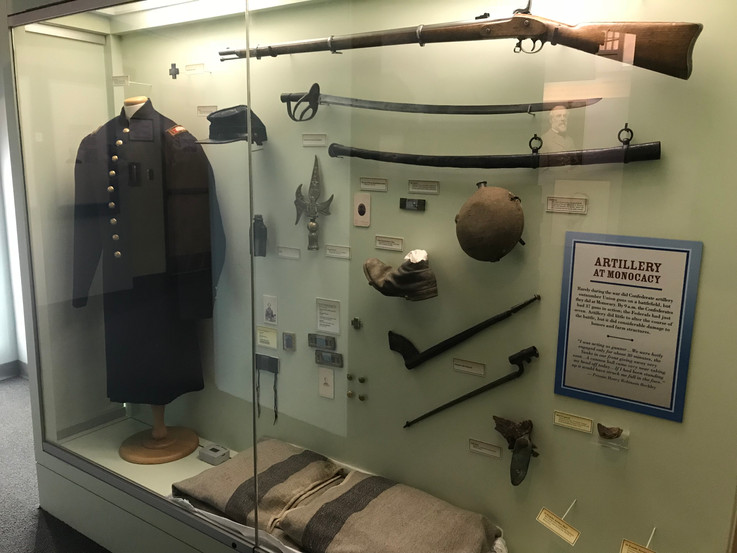In June 1864, Lieutenant General Jubal Early and 15,000 Confederate troops departed from Richmond, VA, and began their advance towards Washington D.C. General Lee hoped to turn the tide of the war with this maneuver. Not only would a successful invasion poise the South for victory, it would also spell political defeat for Abraham Lincoln, who was in the midst of an election campaign. Early and his men encountered little resistance as they made their way up the Shenandoah Valley and across Maryland. When General Ulysses S. Grant learned of the advancing Confederate army, he dispatched 3,000 troops from his Siege of Petersburg to intercept and stop the South's progress. On July 9, when Early's army reached Frederick, MD, they encountered Grant's unexpected reinforcements and 6,600 Union troops, and thus the Battle of Monocacy ensued.

Monocacy Battlefield is comprised of five stops, each with a unique perspective of the battle. Visitors can first stop by the Monocacy Battle Center, tour the museum, and gain some knowledge on the events preceding the battle, its significance, and its impact on the rest of the war.
STOP 1: Best Farm -- On the morning of July 9, the opening shots of the battle were fired here. Confederate artillery and sharpshooters were positioned on Best Farm and were engaged with the Union army on the heights across the river. Union artillery fire caused Best's grain barn to catch fire, destroying his crops and farm tools. To top it all off, the Confederate army burned his fields before they advanced across the river.

A couple years prior to the battle, the lost copy of General Lee's Special Order 191 were found here. The orders detailed his campaign strategy and how his troops would move in the coming days. The lost copy, which was intended for General D.H. Hill, was found by members of the 27th Indiana Infantry wrapped around some cigars.
Preceding the war, the farm and the surrounding area was part of a plantation known as L'Hermitage. Victoire Vincendiere came to Frederick with her family and twelve slaves in 1793. She had escaped the turmoil of the French Revolution and the slave revolts of Saint Domingue (Haitian Revolution). She was intent on establishing a large-scale slave operation in Maryland and owned ninety slaves by 1800. Historians debate whether this slave workforce was for cash crops or a rental business. Regardless, the plan wasn't all too successful, as Vincendiere sold the property in 1827.
STOP 2: New Jersey Monument -- On July 9, 1907, the 43rd Anniversary of the battle, members of the 14th New Jersey gathered here to commemorate a statue in their honor. This monument was the first one dedicated on the battlefield. The site is currently closed due to railway construction, but I didn't see the sign in time so I entered anyway ¯\_(ツ)_/¯. It's a small site and should only take a minute or two to visit.
STOP 3: Worthington Farm -- On the morning of July 9, Confederate General McCausland and his cavalry brigade of 1400 men crossed this farm. Unbeknownst to McCausland, an equal-sized Union force commanded by Brig. Gen. James B. Ricketts laid in wait to ambush his men. Once the Confederates drew close, they opened fire from the corn rows. The surprise attack took McCausland completely off-guard and his army sustained heavy losses. He ordered his troops to fall back and regroup at Worthington Farm.

During the battle, six year-old Glenn Worthington hid in the farmhouse cellar and bore witness to the carnage. He and his family tended to the wounded. While assisting, a cartridge from a smoldering rifle exploded near his face, badly burning the boy. He recovered a few weeks later. Glenn Worthington went on to receive his law degree from the University of Maryland in 1887 and published his first-hand account of the battle in 1932.
There are two hiking trails on the farm: Brooks Hill (1.9 miles) and Ford Loop (1.6 miles). If views are what you're going for, then these trails aren't for you. Both of them are relatively flat and serve primarily as nature trails. Still, they are fun to explore.
STOP 4: Thomas Farm -- Around mid-afternoon, General Gordon and his 3,500 Confederate infantry made their way from Worthington Farm to attack a 3,200-man Union army at Thomas Farm. The Union was holed-up in the pikes and wooded areas of the property and fought fiercely against the Confederate onslaught. However, enemy artillery and flanking maneuvers weakened the Union's defensive line, driving them back to Georgetown Pike.
As the battle drew near, the Thomas family and their guests took refuge in the cellar. Moments later, their house was bombarded with artillery shells and musket fire. When they emerged, they saw a horrific site of hundreds of dead and wounded soldiers strewn across their land.
The Thomas House, known as 'Araby,' was constructed in 1780 by James Marshall. C.K. Thomas bought the property in 1860 to try to get away from the pre-war turmoil in Baltimore. Little did he know his property would see quite the amount of action throughout the war. After the Battle of Antietam, a rebel prisoner believed to be a relative of Robert E. Lee was kept in this house. Later that winter, members of the 14th New Jersey Regiment camped near the property and befriended the Thomas's. In 1863, during the Gettysburg Campaign, Major General Winfield Scott Hancock made the house his headquarters for a few days. During the Battle of Monocacy, the house was shelled pretty hard and took a lot of damage. In addition, it served as a field hospital for the Union wounded. Finally, in August 1864, General Ulysses S. Grant held a Council of War meeting with seven other generals to formulate a plan to destroy the Confederacy.
Like Worthington Farm, Thomas Farm has a couple of nature trails to check out. The Thomas Farm Loop is a 1.75 mile nature path that takes you around the fields where the Union wounded and dead lay. The Middle Ford Ferry Loop is a half-mile trail that takes you down by the river near an old tavern and ferry site. Let's back-track a bit to colonial times. These structures were constructed between 1748-54 and first owned by Daniel Kennedy. The ferry saw some action during the French and Indian War when it transported British General Edward Braddock and his men over the Monocacy River on their march to Fort Duquesne. After the construction of Georgetown Pike and a covered bridge in the early 1800s, the ferry became obsolete and the place was abandoned around 1830.

STOP 5: Gambrill Mill -- Major General Lee Wallace and his Union force were ordered to defend the covered bridge that spanned the Monocacy. If the Confederates reached the bridge, then their advance toward D.C. would be much easier. Wallace and his men fought off the larger Confederate force, but around noon, they had to withdraw to reinforce the rest of the Union Army at Thomas Farm. Before they left, they burned the bridge to prevent the Confederates from using it. By burning the bridge, however, Wallace inadvertently left Lieutenant George E. Davis and his men stranded on the other side of the river. Their only route of escape now was the nearby train tracks. At 4:00 pm, Davis crossed over in an act of desperation. Amazingly, his unit suffered minimal casualties and they were able to regroup with the rest of the army and avoid capture.
Throughout the battle, the mill served as a Union field hospital. After the Union retreat, advancing Confederates found 42 dead and wounded soldiers in the building. The mill still stands today, but much differently than it looked in the past. The third level of the building was taken off and the mill run filled in the early 20th century while converting it into a house. Today, it serves as park administrative offices. The Gambrill Mill Trail Loop, which starts next to the mill, is a half-mile easy walk around the Union line and river.
Another neat feature of the site doesn't have much to do with the Civil War at all. Perched on top of a hill overlooking the mill sits Gambrill Mansion, known as 'Edgewood.' James Gambrill, owner of the mill, built this three-story, Second Empire-style mansion in 1872. Gambrill had seen plenty of success since purchasing the mill in 1855, and his home certainly displayed his wealth and prosperity. Not only was this house one of the biggest in Frederick County with 17 rooms and seven fireplaces, it also featured Italian marble mantles, running water, and a grand staircase. While the house is beautiful, it looks like it belongs on American Horror Story or something...it looks like your stereotypical haunted house, but nonetheless quite the impressive mansion.
While the Battle of Monocacy was a tactical Confederate victory, it ended up being a strategic Union victory in that the battle delayed the Confederate's advance on Washington. This proved costly, since it allowed thousands of additional Union troops from Petersburg to arrive and defend the capital. Just hours before his planned attack, Early reassessed the situation and found the odds to be too great. On July 12, 1864, he withdrew his troops from Fort Stevens, MD, and marched back into Virginia. If it wasn't for this engagement, Early might have made it to the capital before Union reinforcements could arrive, and the outcome of the war could've been much different.
For more information on Monocacy: https://www.nps.gov/mono/index.htm































